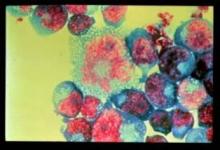SEATTLE – HIV-infected individuals have increased arterial inflammation compared with their uninfected counterparts with the same levels of traditional cardiovascular risk factors, even when the infection is so well controlled that the virus is undetectable.
This was among the key findings of an observational study of 81 individuals who underwent fluorodeoxyglucose positron emission tomography (FDG-PET). Inflammation in the thoracic aorta was assessed from the target-to-background ratio of tracer uptake.
 Courtesy Dr. Tom Folks, NIAID/National Institutes of Health
Courtesy Dr. Tom Folks, NIAID/National Institutes of Health
This photo shows HIV-infected T cells. The study results showed that inflammation in HIV-positive subjects – none of whom had known cardiac disease and all of whom were on antiretroviral therapy (ART) – was greater than that in HIV-negative individuals having matching Framingham Risk Scores.
Study results, reported at the Conference on Retroviruses and Opportunistic Infections, showed that inflammation in the HIV-positive individuals – none of whom had known cardiac disease and all of whom were on antiretroviral therapy (ART) – was greater than that in HIV-negative individuals having matching Framingham Risk Scores (2.23 vs. 1.89, P = .0003). Moreover, it was about equal to that in HIV-negative individuals who had known atherosclerosis (2.13).
The findings were the same when only HIV-positive patients having an undetectable viral load – the large majority of those studied – were included in analyses, reported coinvestigator Dr. Steven Grinspoon, director of the Program in Nutritional Metabolism at Massachusetts General Hospital, Boston.
"The HIV-infected patients, essentially with total virological suppression and very low Framingham Risk Scores – a group that you would ordinarily not be particularly concerned about – had very significant arterial inflammation compared to the Framingham Risk Score–matched controls," he commented. "Moreover, this group of HIV-infected patients basically had the same degree of arterial inflammation as the group of non-HIV patients with known cardiovascular disease [CVD], except that the HIV patients didn’t have known CVD."
Previous research has suggested that arterial FDG uptake like that observed is due to macrophage accumulation at the interface between the lipid core and the fibrous cap in atherosclerotic plaques (Circulation 2002;105:2708-11). And results of the new study indeed showed that arterial inflammation in the HIV-positive group was correlated with levels of soluble CD163, a marker of monocyte activation. Dr. Grinspoon speculated that the heightened arterial inflammation may thus reflect chronic immune activation.
"Increased arterial inflammation in well-controlled subjects on ART is likely to contribute to increased CVD rates in this population," he maintained. "Strategies to target this inflammation, in addition to targeting traditional risk factors, including potential strategies to reduce monocyte activation, may be useful and should be investigated."
Session attendees questioned whether there was a confounding effect of statins, which are known to be anti-inflammatory and were used by none of the HIV-positive group, a quarter of the risk-matched HIV-negative group, and two-thirds of the HIV-negative group with known atherosclerosis. But Dr. Grinspoon noted that several analyses taking statin use into account yielded the same results.
When asked if he had any hypotheses as to what is activating the monocytes and whether microbes may have a role, he replied, "We are just beginning to look at some of the other markers. The whole entire cascade of macrophage activation and [microbial translocation] needs to be looked at more carefully."
Another attendee wondered if the duration of HIV infection influenced inflammation, given that most patients studied had been infected for at least a decade. "It would be absolutely fascinating ... to look at ART-naïve patients at the height of their [viral levels]," Dr. Grinspoon replied. "I would predict that the elevation will be even higher in those and that going on to ART will slam it down, and then it festers along at a certain kind of low-grade level. Our point in this study is that festering along is a problem because there seems to be at least arterial inflammation, even when you think, ‘Oh, the patient is fine, their viral load is suppressed.’ "
The investigators enrolled in the study 27 HIV-positive patients free of known cardiac disease who were on stable ART and did not have any opportunistic infections; 27 HIV-negative individuals matched for age, sex, and Framingham Risk Score who had no known atherosclerosis; and 27 HIV-negative patients matched for sex who had known atherosclerosis.
On average, the members of the HIV-positive group were 52 years old, had been infected for 16 years, and had been on ART for 12 years, according to Dr. Grinspoon, who disclosed no relevant conflicts of interest related to the research. Their mean CD4 count was 592 cells/mm3, and three-fourths had undetectable HIV RNA. Their average Framingham Risk Score was 6.4.

